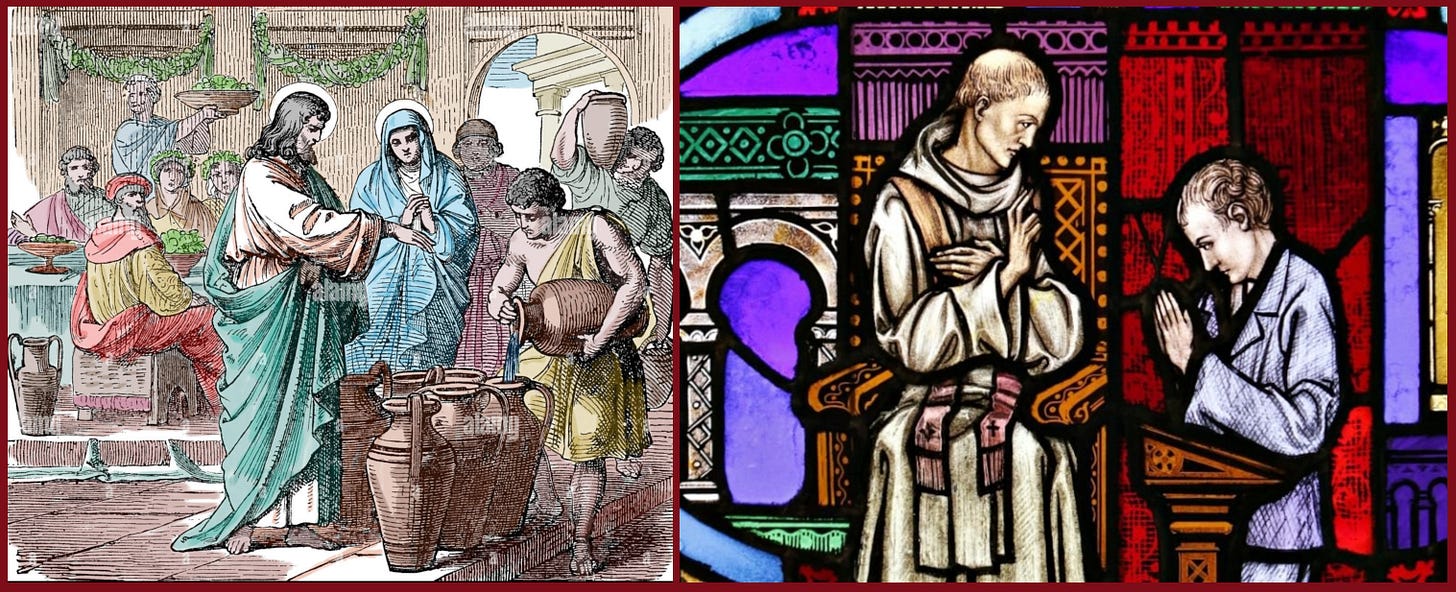Multiverse Journal - Index Number 2224:, 21st July 2025, Meditations on Wedding at Cana, Sacrament of Reconciliation
Journal across Realities, Time, Space, Soul-States.
URL: https://notebooklm.google.com/notebook/34f1f037-b36f-4914-b683-49f5a5da91fc
—
July 21st, 2025
Good Monday,
May the Spirit of the Gospel and the Holy Word be Always on our Tongues, in our Hearts, Minds, and in our Hands.
Holy Virgin Mother Mary and All Saints - Pray for us!
—
Index Number 2224:
— —
May this article find us all ever closer to God, and His Clarity.
Here I offer my Meditations on Wedding at Cana as a Foreshadowing of the Sacrament of Reconciliation.
My research using a number of AIs (Google Gemini, Grok|xAI DeepSearch, ChatGPT) suggests that no widely recognized theologians have explicitly connected the Wedding at Cana to the Sacrament of Reconciliation. However, indirect themes in some sources, such as the need for repentance and confession in union with Christ, align with this interpretation. This apologetic appears to offer a novel perspective, which, while not widely documented, fits within the typological and symbolic framework of Catholic sacramental theology.
This Inspiration required some knowledge of 2nd Temple Judaism that Jesus was raised under, and Completed in His Sacrifice, Passion, Death, Resurrection and Creating the True Jewish Church, Catholic Church, with Jesus Christ as the Holy Eternal Living Temple.
God Bless., Steven
The Wedding at Cana: A Foreshadowing of the Sacrament of Reconciliation
Abstract
The Wedding at Cana (John 2:1-11), Jesus’ first public miracle, is a narrative steeped in theological symbolism. This article proposes that its elements—purification jars, the servants’ obedience, Mary’s intercession, and the transformation of water into wine—foreshadow the Sacrament of Reconciliation. By exploring these through a traditional Catholic lens, it highlights how the sacrament surpasses 2nd Temple Judaism’s ritual cleansing, offering complete forgiveness and abundant grace, while underscoring Mary’s unique role as Co-Redemptrix through her shared Sacred Heart with Christ.
Introduction
The Gospel of John’s account of the Wedding at Cana marks the beginning of Jesus’ public ministry with a miracle that extends beyond providing wine. Its rich symbolism invites interpretation, particularly as a prefigurement of the Sacrament of Reconciliation. This article argues that the narrative’s details reflect the dynamics of confession, absolution, and spiritual renewal, surpassing the limitations of Jewish purification rites and revealing the profound intercessory role of Mary, whose Sacred Heart links her to Christ’s redemptive mission.
The Setting: Jars of Purification and the Acknowledgment of Impurity
The text identifies “six stone water jars there for the Jewish custom of purification, each holding twenty or thirty gallons” (John 2:6). Used for rituals like netilat yadayim (handwashing before meals), these jars were central to 2nd Temple Judaism’s pursuit of ritual purity under the Law. The water, repeatedly employed for cleansing, symbolically carried the “impurities” individuals sought to remove, serving as a ritualistic acknowledgment of uncleanness—a precursor to confession. However, this cleansing was incomplete, as the “dirty” water in the jars reflected the lingering effects of sin, a limitation overcome only by Christ’s transformative grace in the Sacrament of Reconciliation.
The Servants’ Role: Channeling Grace from the Church’s Treasury
When the wine runs out, Mary instructs the servants, “Do whatever he tells you” (John 2:5), and Jesus commands them to fill the jars with water, which they do “to the brim” (John 2:7). The servants symbolize the ordained ministers of the Church—deacons, priests, and bishops—who, acting in persona Christi (CCC 1548), channel divine grace without their own power. This act of adding fresh water to the symbolically “unclean” jars represents the Church’s application of grace from the Treasury of Merits—the infinite value of Christ’s sacrifice, enriched by the merits of Mary and the saints (CCC 1476-77). The jars filled to the brim signify the abundant mercy available through the Church, surpassing the partial purification of old rites.
The Stone Jars: Immutability of the Sacred Ministry
The jars’ stone construction holds deep meaning. Unlike clay vessels, which could become ritually impure and required breaking, stone was impervious to defilement (Mishnah Kelim 10:1). This mirrors the priest in Reconciliation, who, acting in Christ’s person, remains untainted by confessed sins (CCC 1466). The jars also symbolize the confessional—a sacred space where mercy prevails despite sin’s burden. This immutability underscores the enduring sanctity of the ministerial office, a stark contrast to the temporary purity of 2nd Temple rituals.
Mary’s Intercession: Guiding Souls to Divine Mercy
Mary’s role is pivotal, beginning with her observation of the wine shortage (“They have no wine”) and her directive to the servants. Her intercession initiates the miracle, foreshadowing her role as Mother of the Church and advocate (CCC 969). Her value as Co-Redemptrix—subordinate to Christ’s unique redemption (CCC 618)—is heightened by her shared Sacred Heart with Jesus, from whose human body she contributed. This intimate union, formed through her flesh, amplifies her intercessory power, guiding souls to Christ’s mercy. Jesus’ response, “My hour has not yet come,” reflects His adherence to the Father’s timetable, yet Mary’s faith, channeled through the servants (the Church), may inspire the Holy Spirit to guide Him to begin His ministry. This dynamic aligns with Reconciliation, where human plea, facilitated by Mary and the Church, meets divine will to dispense grace.
The Miracle: Transformation, Absolution, and Holy Purpose
The transformation of water into wine is the narrative’s climax. The water, symbolizing the incomplete purification of 2nd Temple Judaism with its lingering “dirty” effects of sin, becomes wine—emblematic of joy and new life (Psalm 104:15). In Reconciliation, Christ’s absolution removes sins and transforms their damage to the soul and others into abundant grace, surpassing the old rites’ limitations. This mirrors the Fall of Adam, redeemed by Christ’s sacrifice and resurrection into greater glory (CCC 412). While sin itself is not glorified, God’s mercy turns its consequences—guilt, relational harm—into spiritual growth, humility, and mission, filling the forgiven with the “new wine” of grace.
The Master’s Unwitting Testimony to Divine Quality
The master of the banquet, unaware of the miracle, praises the wine’s quality: “Everyone serves the good wine first, and then when people have drunk freely, then the inferior. But you have kept the good wine until now!” (John 2:10). This unbiased commendation authenticates the miracle’s excellence, reflecting the objective efficacy of Reconciliation (CCC 1127). The renewed joy and peace in the penitent, unrecognized by the world, testify to Christ’s surpassing grace, the Bridegroom who saves the best for the New Covenant, far exceeding the old purification’s scope.
Conclusion
The Wedding at Cana emerges as a profound foreshadowing of the Sacrament of Reconciliation. The purification jars’ incomplete cleansing, the Church’s ministerial role, Mary’s intercession through her shared Sacred Heart, and the transformative miracle reveal God’s mercy. Surpassing 2nd Temple rituals, Reconciliation removes sin and transforms its effects into abundant grace, echoing the Fall’s redemption. This narrative invites the faithful to embrace the sacrament as a joyous encounter with divine mercy, a testament to Christ’s power and the Church’s mission.
Appendix: Quoted References
CCC 117: “The Church, as the sacrament of intimate union with God and of the unity of the whole human race, has a specific role in interpreting Scripture typologically, that is, as containing figures and symbols that prefigure the New Covenant in Christ.”
CCC 1548: “In the ecclesial service of the ordained minister, it is Christ himself who is present to his Church as Head of his Body, Shepherd of his flock, high priest of the redemptive sacrifice, Teacher of Truth.”
CCC 1476-77: “The treasury of the Church is the infinite value, which can never be exhausted, which Christ’s merits have before God. They were offered so that the whole of mankind could be set free from sin and attain communion with the Father. In Christ, the Redeemer himself, the satisfactions and merits of his Redemption exist and find their efficacy. This treasury includes as well the prayers and good works of the Blessed Virgin Mary, who is joined by an inseparable bond of love with her Son, and of all the faithful who have been made holy by Christ’s grace and have contributed to the building up of his Body, the Church.”
CCC 1466: “The confessor is not the master of God’s forgiveness, but its servant. The minister of this sacrament should unite himself to the intention and charity of Christ. The forgiveness of sins is the fundamental condition of Christian life, and the sacrament of Penance is the ordinary means by which God grants it.”
CCC 969: “The Virgin Mary… is acknowledged and honored as being truly the Mother of God and of the redeemer… She is invoked in the Church under the titles of Advocate, Helper, Benefactress, and Mediatrix.”
CCC 1449: “The sacrament of Penance… reconciles man with God… [and] repairs the communion with the Church which is ruptured by sin.”
CCC 1468: “The whole power of the sacrament of Penance consists in restoring us to God’s grace and joining us with him in an intimate friendship. Reconciliation with God is thus the purpose and effect of this sacrament.”
CCC 412: “God permits evil in order to draw forth some greater good… Hence St. Paul can say: ‘Where sin increased, grace abounded all the more.’ The Church has always taught that God, being infinitely good, would never permit evil unless he could bring good out of it.”
CCC 1127: “Celebrated worthily in faith, the sacraments confer the grace that they signify. They are efficacious because in them Christ himself is at work: it is he who baptizes, he who acts in his sacraments in order to communicate the grace that each sacrament signifies.”
PS. Do you know someone that might like to consider this?



